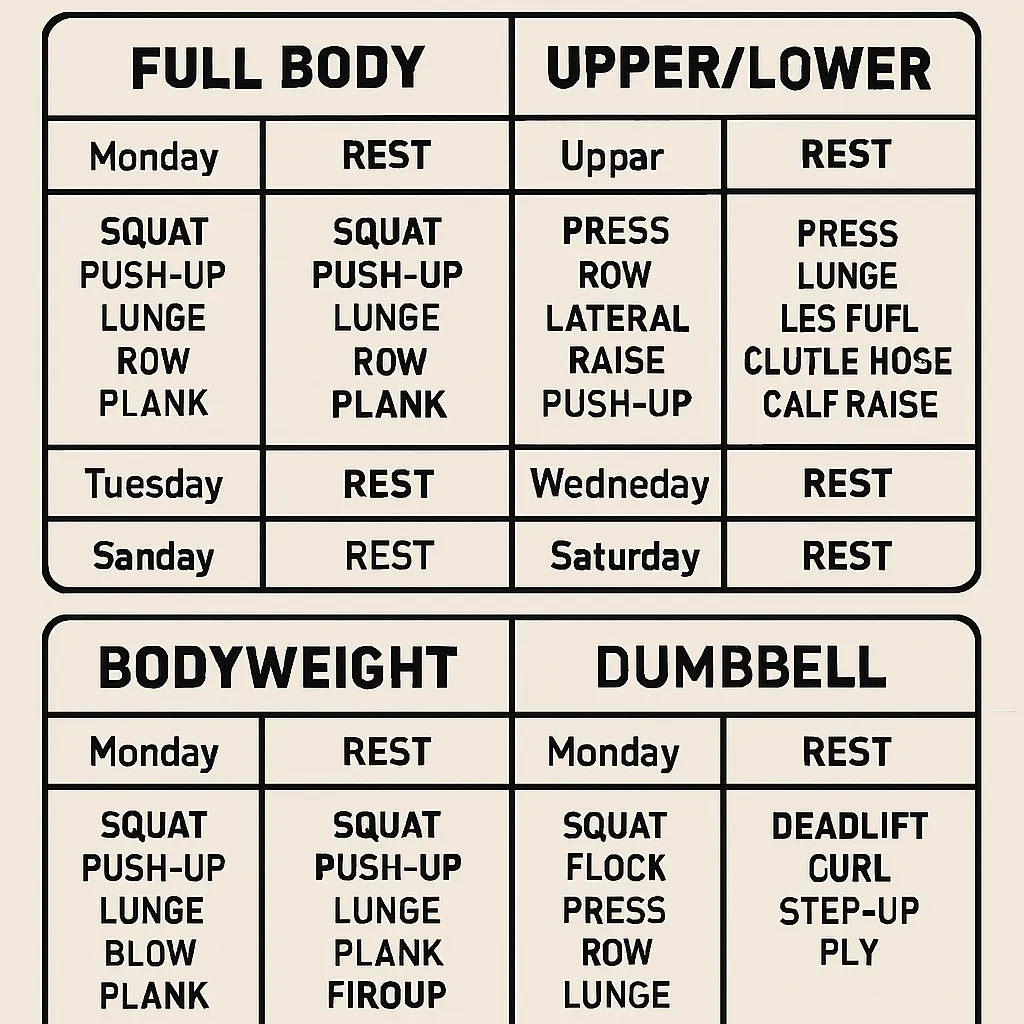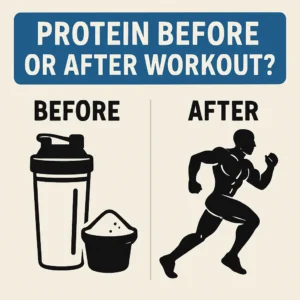Finding an effective home workout plan can transform how you approach fitness, whether you’re just starting out or you’re a seasoned athlete. In this article, we’ll explore the benefits of working out at home, share routines tailored for beginners, intermediates, and advanced exercisers, and provide equipment-free options that you can do anytime. You’ll learn how to set realistic goals, track your progress, and stay motivated on your fitness journey. We’ll also answer common questions about home workouts, including their effectiveness and how to maintain consistency. Our goal is to equip you with everything you need to succeed without stepping foot in a gym.
Benefits of Home Workouts
Home workouts remove many of the barriers that prevent people from exercising regularly. You can work out on your own schedule, avoid crowded gyms, and save both time and money. The flexibility of home-based routines means you can tailor them to your environment, whether you have a spare room, a garage, or just a small corner of your living area. Home workouts also encourage consistency, since the “travel time” to your workout space is negligible. Over time, this consistency compounds into real fitness gains and improved health markers.
Another major benefit is personalization: you can focus on the exact movements and intensities that suit your body and goals without feeling self-conscious. If you’re recovering from an injury or have mobility limitations, you can adjust exercises on the fly. In addition, home workouts often require minimal or no equipment, making them highly accessible. Over time, you’ll build confidence as you master your routine at your own pace. Finally, exercising at home can help you establish a stronger mind-body connection, since there are fewer distractions than in a busy gym environment.
Why Choose Home Workouts Over Gym Workouts?
Choosing home workouts over a gym membership can save you hundreds, if not thousands, of dollars each year. Gym fees, commuting costs, and the price of fancy gear can add up quickly, while many home workout plans simply use bodyweight or low-cost equipment. Moreover, exercising at home streamlines your schedule—you can jump into a quick session between meetings, during your lunch break, or right after the kids are in bed. There’s no waiting for machines or dealing with peak-hour crowds, so you can maintain workout flow and intensity.
Mental comfort is another key factor: if you feel intimidated by gym-goers or self-conscious about your form, home workouts provide a private environment where you can learn and progress without judgment. You can also readily integrate workouts with entertainment—watching your favorite show or listening to your best playlist can make exercise feel like a treat rather than a chore. Over time, you may find you’re more consistent and more motivated when working out in a familiar space.
Mental and Physical Health Benefits
Exercise has well-documented mental health benefits, and home workouts are no exception. Regular physical activity boosts endorphins, reducing symptoms of stress, anxiety, and depression. When you work out in your own space, you also cultivate a routine that signals “self-care time,” which can enhance mindfulness and relaxation. Additionally, end-of-day or early-morning sessions can improve sleep quality, helping you wake up refreshed or wind down more easily at night.
Physically, home workouts can improve cardiovascular health, increase muscle strength, and enhance joint mobility. Whether you’re doing dynamic warm-ups, resistance movements, or cool-down stretches, you’ll notice improvements in posture, balance, and coordination. Consistent exercise supports immune function, aids weight management, and can reduce the risk of chronic diseases such as type 2 diabetes and hypertension. Over time, you’ll also develop better body awareness, helping you maintain good form and prevent injuries in daily life.
Beginner Workout Plans
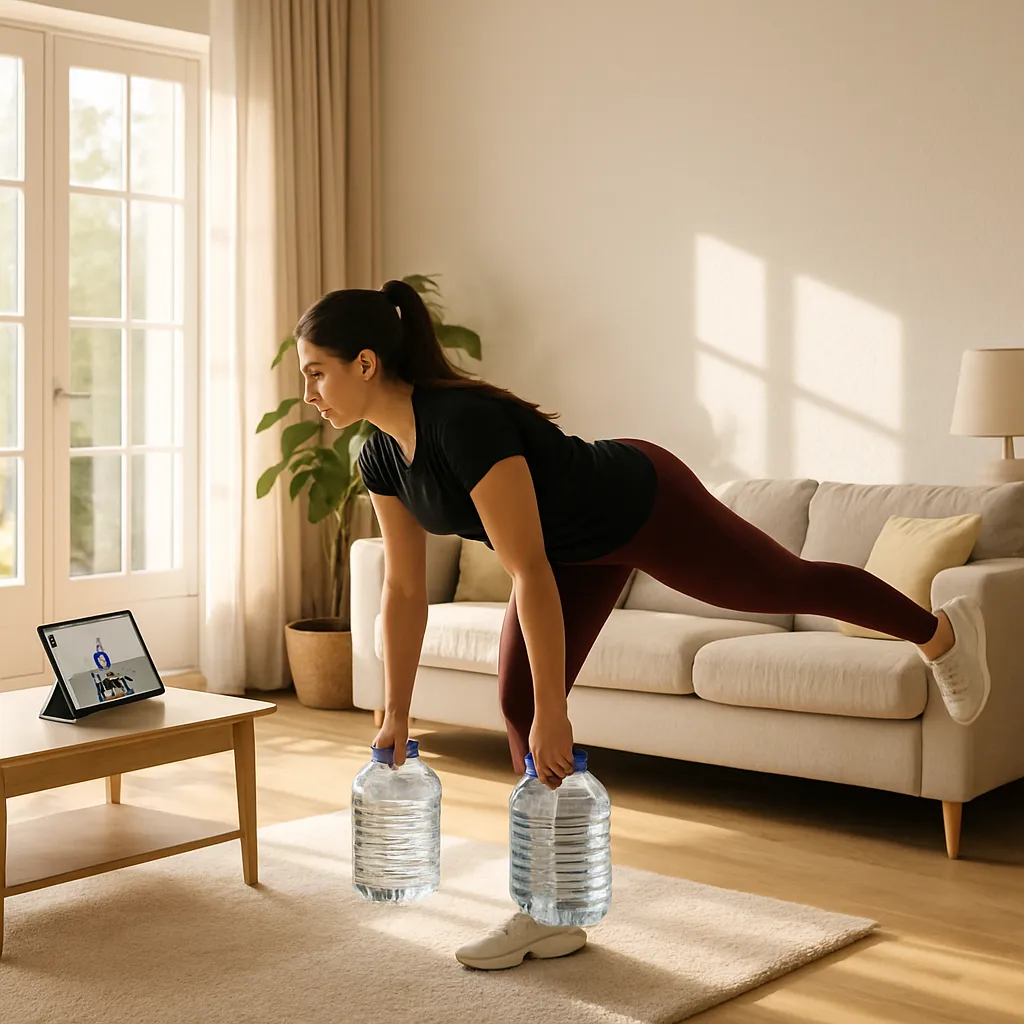
Starting a fitness routine at home can feel overwhelming if you’re new to exercise. That’s why beginner plans focus on foundational movements and gradual progression. You’ll learn how to warm up safely, perform basic bodyweight exercises, and cool down effectively. These easy-to-follow routines build confidence, ensure proper form, and lay the groundwork for more advanced workouts. Most beginner plans require no equipment, making them perfect for anyone looking to develop healthy habits without investing in gear.
Beginners should aim for three to four sessions per week, each lasting 20 to 30 minutes. As you grow stronger, you can add more sets, increase repetitions, or introduce light resistance bands or dumbbells. Remember, the key is consistency—showing up regularly will deliver better results than sporadic high-intensity sessions. Listen to your body, rest when needed, and gradually challenge yourself to improve over time.
Easy-to-Follow Routines for Starters
Below is a simple routine to kickstart your home fitness journey. Perform each exercise for the prescribed time or reps, then rest briefly before moving on to the next movement. Complete two rounds to start, then gradually increase to three as you feel comfortable.
- Squats: 10–12 reps — Stand with feet shoulder-width apart, sit back into your hips, and return to standing.
- Incline Push-Ups: 8–10 reps — Use a stable chair or countertop to reduce load.
- Glute Bridges: 12–15 reps — Lie on your back, feet flat, lift hips toward the ceiling.
- Plank: 20–30 seconds — Keep body in a straight line from head to heels.
- Marching in Place: 30 seconds — Lift knees high, engage your core.
Perform this circuit three times per week, ensuring at least one rest day between sessions. Track your reps and times in a simple notebook or digital tracker. Celebrate small wins, like holding a plank longer or adding an extra rep. Over the first month, you should feel increased strength, better posture, and more energy throughout the day.
Essential Warm-Up and Cool-Down Exercises
A proper warm-up prepares your muscles and joints for exercise by increasing blood flow and raising core temperature. Begin with dynamic movements for 5–7 minutes to reduce injury risk and enhance performance. After your workout, a cool-down helps clear lactic acid, promote flexibility, and bring your heart rate down gradually. Skipping these steps can lead to stiffness, soreness, and slower recovery.
Here’s a beginner-friendly warm-up and cool-down sequence:
- Warm-Up: Arm circles, torso twists, hip openers, leg swings, light marching.
- Cool-Down: Forward fold, quad stretch, seated hamstring stretch, child’s pose.
Always hold static stretches for at least 20 seconds, breathing deeply to maximize muscle relaxation. Incorporating foam rolling or gentle self-massage can further aid recovery and keep you feeling limber for your next workout.
Intermediate Workout Plans
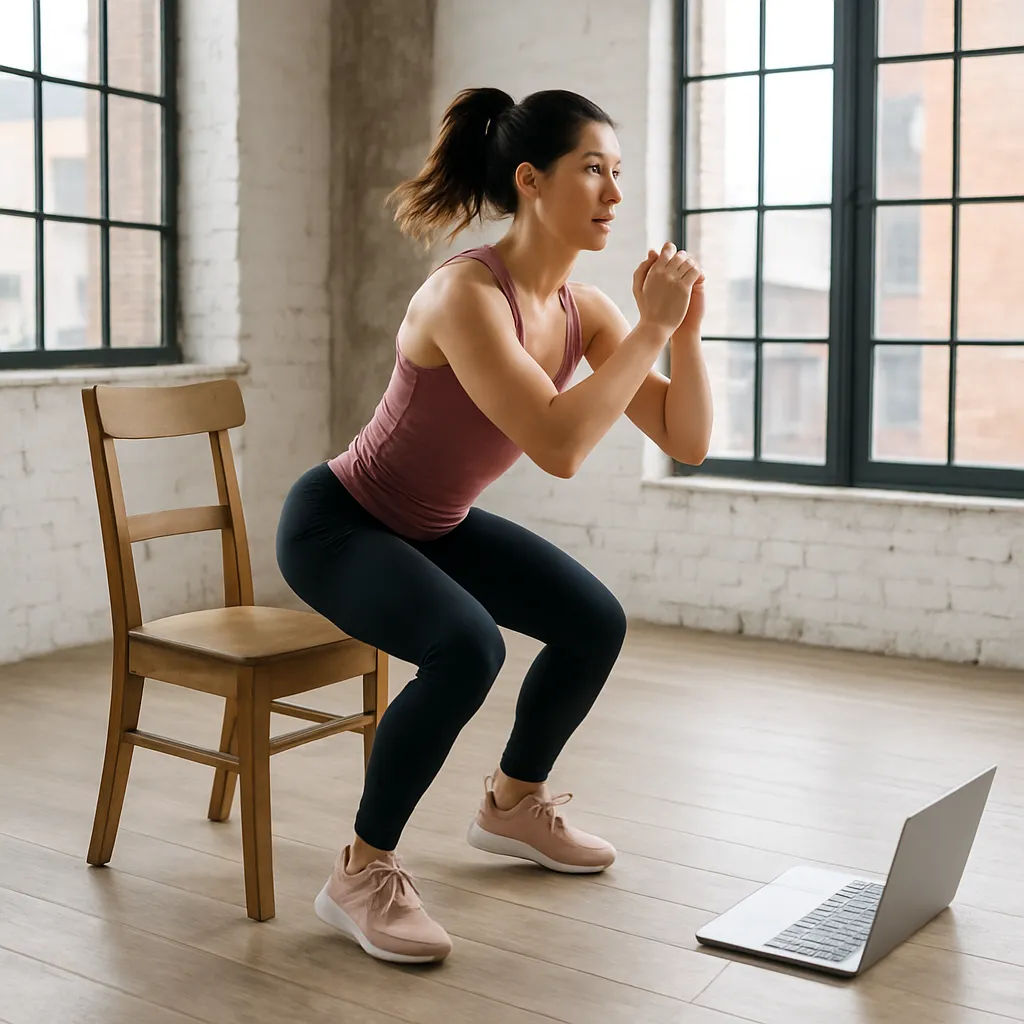
Once you’ve built a foundation of strength and confidence, it’s time to elevate your home workouts. Intermediate plans introduce more challenging movements, higher volumes, and light-to-moderate resistance. You’ll combine bodyweight exercises with dumbbells, resistance bands, or kettlebells to stimulate new muscle growth and break through plateaus. These routines typically last 30–45 minutes and include supersets or circuit formats to boost cardiovascular demand.
Perform intermediate workouts 4–5 times per week, alternating between upper-body, lower-body, and full-body days. Prioritize form over load—improper technique can lead to injuries. Keep rest periods brief to maintain intensity, but extend them if you need extra recovery. As you progress, track your weights, reps, and times to ensure steady improvement.
Elevate Your Fitness with These Routines
Your intermediate routine might look something like this, using moderate weights and tempo variations. Aim for 3–4 sets of each superset, with 8–12 reps per exercise unless otherwise noted.
- Superset 1: Bulgarian Split Squats (each leg) + Dumbbell Chest Press.
- Superset 2: Resistance Band Rows + Overhead Dumbbell Press.
- Superset 3: Deadbugs + Single-Leg Romanian Deadlift.
- Finisher: Mountain Climbers, 40 seconds on, 20 seconds rest ? 3 rounds.
Record your weights and reps in a fitness app or workout journal. Aim to increase either load or reps every two weeks. This progressive overload principle is key to continued adaptation and strength gains. Combine these workouts with proper nutrition and adequate sleep to maximize results.
Incorporating Cardio and Strength Training
Balancing cardio with strength work optimizes both fat loss and muscle development. On intermediate plans, consider 2–3 days of dedicated cardio, such as jump rope, running drills, or HIIT circuits. Alternate these with strength sessions to allow muscle groups time to recover. For example, you might do strength on Monday, Wednesday, and Friday, and cardio on Tuesday and Thursday.
High-Intensity Interval Training (HIIT) is particularly efficient for busy schedules. A 20-minute HIIT session can boost metabolism and improve cardiovascular capacity. Always include a brief 3–5 minute warm-up and cool-down for safety. Over time, you’ll notice improved endurance, a leaner physique, and enhanced overall fitness.
Advanced Workout Plans
Advanced home workout plans are designed for experienced exercisers seeking intense stimuli and specialized goals. These routines often feature complex movements, heavy loads, plyometrics, and extended metabolic finishers. You might incorporate barbells, heavier kettlebells, or creative DIY equipment like sandbags. Advanced plans also emphasize periodization—alternating between hypertrophy, strength, and power phases to continually challenge your body.
Workouts last 45–60 minutes, with 5–6 sessions per week. Each day may focus on a specific muscle group or training quality (e.g., speed, strength, endurance). Advanced trainees must pay close attention to recovery protocols, including nutrition, sleep, mobility work, and possibly supplementation under professional guidance.
Challenge Yourself with High-Intensity Workouts
Below is an example of a week-long advanced split. Adjust volumes and loads based on your strength levels and recovery capacity. Always begin with a thorough warm-up and end with a dedicated cool-down.
| Day | Focus | Key Exercises | Sets ? Reps / Time |
|---|---|---|---|
| Monday | Leg Strength | Back Squat, Bulgarian Split Squat, Box Jumps | 4?5 / 3?8 / 3?10 |
| Tuesday | Upper Push | Bench Press, Dips, Plyo Push-Ups | 4?6 / 3?10 / 3?8 |
| Wednesday | Conditioning | Sled Push, Battle Ropes, Burpees | 5?30s / 5?30s / 5?15 |
| Thursday | Upper Pull | Deadlift, Pull-Ups, Renegade Rows | 4?5 / 4?Max / 3?8 |
| Friday | Full Body Metcon | Thrusters, Kettlebell Swings, Toes-to-Bar | AMRAP 20 min |
| Saturday | Active Recovery | Yoga Flow, Foam Rolling | 30–45 min |
| Sunday | Rest | — | — |
This table illustrates how to structure intensity, volume, and variety across a training week. Ensure you rotate in different exercises and periodically deload to prevent overtraining. Advanced athletes often benefit from professional programming and coaching feedback to fine-tune technique and strategy.
Tips for Maximizing Results
Maximizing results at an advanced level requires meticulous attention to recovery, nutrition, and data-driven adjustments. Track your workouts in a journal or digital app, noting loads, reps, rest periods, and subjective exertion. Review trends every 4–6 weeks to identify when to increase volume or intensity and when to schedule deloads.
Nutrition is equally crucial: aim for a balanced intake of protein, carbohydrates, and healthy fats to support muscle repair and energy demands. Hydrate consistently, and consider targeted supplementation—creatine, whey protein, or branched-chain amino acids—if appropriate. Finally, prioritize sleep and stress management, as these factors profoundly influence performance, recovery, and long-term progress.
Equipment-Free Workout Options
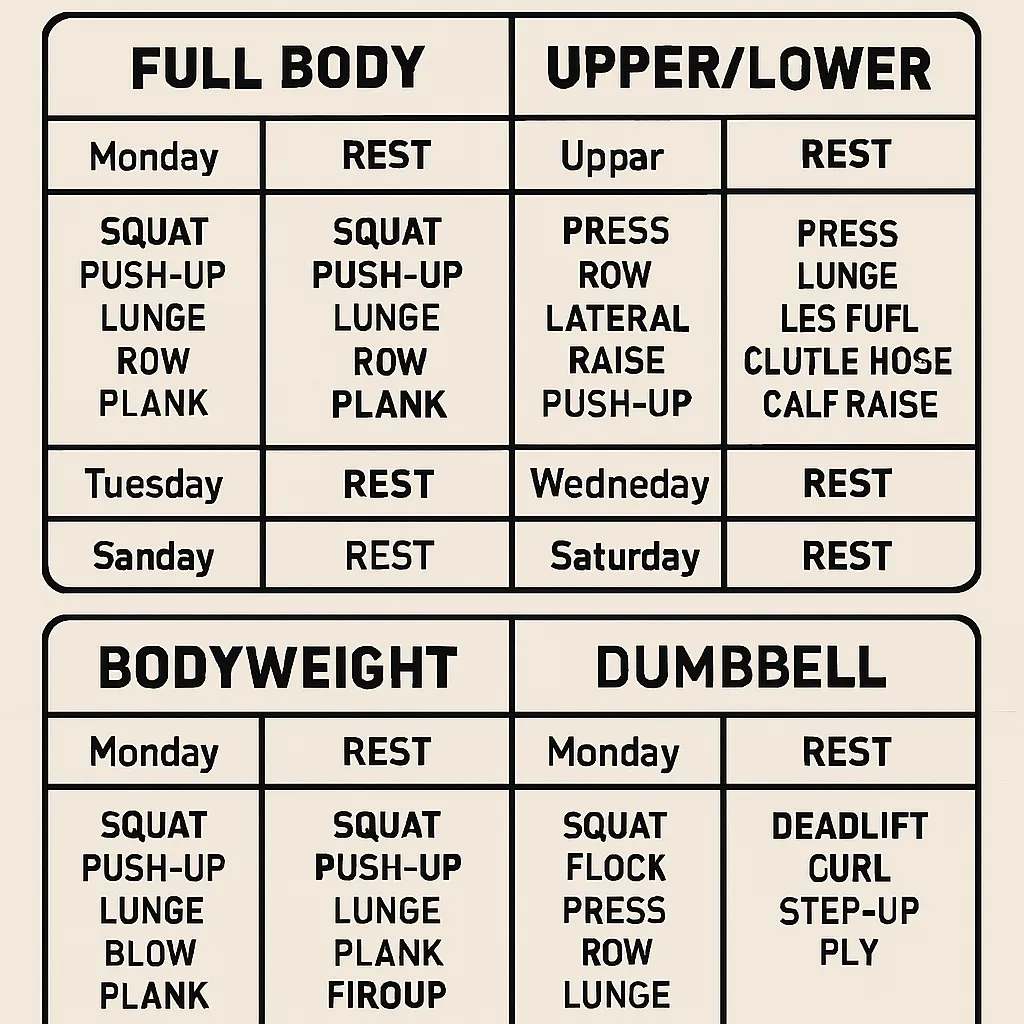
Not everyone has access to weights or machines, but you can still get a powerful workout using only your body. Equipment-free routines rely on leverage, tempo, and creative variations to challenge every muscle group. These workouts can be done anywhere—your living room, backyard, hotel room, or park. With minimal time investment, you can boost strength, endurance, and mobility without gear.
Focus on mastering basic bodyweight patterns—push, pull, hinge, squat, and plank—and then modify leverage or tempo to increase difficulty. For example, elevate your feet for push-ups, pause at the bottom of a squat, or perform single-leg variations. When you learn to load your body effectively, you’ll discover countless ways to progress without ever touching a dumbbell.
Bodyweight Exercises You Can Do Anytime
Here’s a selection of bodyweight movements that target all major muscle groups and can be scaled for any fitness level:
- Push-Up Variations (regular, incline, decline, diamond)
- Squat Variations (air squat, pistol squat progression, Bulgarian split squat)
- Hinge Movements (glute bridge single-leg, hip thrust)
- Core Builders (plank variations, hollow body hold, bird dog)
- Plyometrics (jump squats, burpees, tuck jumps)
Perform circuits of 5–6 exercises, 30–45 seconds each, with 15–20 seconds rest. Complete 3–4 rounds for an efficient full-body session that builds strength and cardiovascular fitness simultaneously. Adjust work and rest intervals to match your goals: longer work phases for endurance, shorter rest for intensity.
Creating a No-Equipment Routine
To design a balanced no-equipment routine, include movements that cover the five fundamental patterns: squat, hinge, push, pull, and core. Rotate exercises weekly to prevent plateaus and keep your muscles adapting. For example, you might swap squats for lunges, push-ups for dips (using a chair), and planks for leg raises.
A sample 30-minute routine might look like this:
- Warm-Up: Dynamic leg swings, arm circles, hip rotations (5 minutes).
- Circuit (3 rounds): Air Squats ? 15, Push-Ups ? 12, Glute Bridges ? 20, Plank ? 45 seconds, Jumping Jacks ? 30.
- Cool-Down: Static stretches and deep breathing (5 minutes).
This format ensures you target every muscle group while keeping intensity high and time investment low. As you progress, increase reps, add pulses or holds, or reduce rest periods to maintain challenge.
Planning Your Home Fitness Journey
Success in home fitness hinges on more than just workouts—it requires planning, goal-setting, and monitoring. Without the structure of gym classes or personal training sessions, you must create your own framework for consistency. Start by defining your “why”: weight loss, muscle gain, improved health, or stress relief. Clear objectives guide your program design and keep you motivated on tough days.
Create a weekly schedule that balances training, rest, and active recovery. Allocate specific days and times for workouts, just as you would for important appointments. Use digital calendars, habit-tracking apps, or a simple paper planner to stay accountable. Remember to build in flexibility for life’s unpredictability—don’t bail on your routine just because your schedule shifts.
Setting Realistic Goals
Effective goals follow the SMART framework: specific, measurable, achievable, relevant, and time-bound. Instead of saying, “I want to get fit,” define “I want to perform 20 push-ups in a row within 8 weeks,” or “I want to lose 5 kilograms in 12 weeks.” These precise targets help you choose the right workouts, track milestones, and adjust strategies if you plateau.
Break large goals into smaller milestones—weekly or monthly targets—that you can celebrate along the way. For instance, aim to add two push-up reps each week or increase plank hold by five seconds. This incremental progress fosters confidence and keeps you engaged over the long haul. Share your goals with friends, family, or online communities to add an extra layer of accountability and support.
Tracking Your Progress
Monitoring your workouts and body measurements provides objective feedback on your progress. Use a combination of methods:
- Workout Journal or App: Record exercises, reps, weights, times, and notes on how you felt.
- Progress Photos: Take front, side, and back photos every 4–6 weeks under consistent lighting.
- Measurements: Track weight, body fat percentage (if available), and circumference measurements (waist, hips, arms).
- Performance Tests: Retest your max reps (push-ups, squats, plank hold) monthly.
Regular tracking not only reveals physical changes but also highlights areas needing adjustment. If you stall, consider tweaking volume, intensity, or nutrition. Celebrate every improvement—no matter how small—to maintain momentum and enjoyment of your fitness journey.
